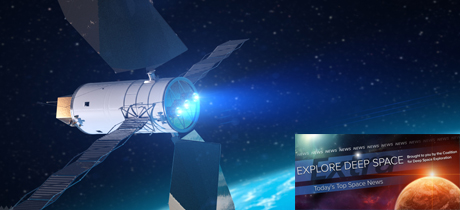In Today’s Deep Space Extra… Several companies offered the U.S. House Space Subcommittee a look at the potential of Solar Electric Propulsion as a source of advanced in space propulsion.
Human Space Exploration
Giving a push for in-space propulsion
The Space Review (7/17): Several companies offered the U.S. House Space Subcommittee a look at the potential of Solar Electric Propulsion as a source of advanced in space propulsion during a June hearing. Congress is expected to go along with plans to cancel NASA’s Asteroid Redirect Mission, a proposal from the Obama administration to retrieve a boulder from an asteroid and maneuver it into lunar orbit that would also demonstrate SEP as a technology supporting the future human exploration of Mars. Initially looking to a solar power source, the technology would transition to a nuclear source capable of pushing humans as well as cargoes deep into the solar system. NASA’s planned Deep Space Gateway, a lunar orbiting habitat, may offer another opportunity for a SEP demonstration.
Russia launches work to design new outfit for spacewalks
TASS of Russia (7/17): Russian researchers are looking at additional upgrades to Russia’s space suit design, making it easier to get into, equipping it with a new control panel and lending the suits a sleeker outer line.
What could space archaeologists tell us about astronaut culture?
Space.com (7/17): A University of Chicago researcher believes an astronaut culture, distinct from terrestrial cultures, is emerging among those living and working aboard the International Space Station.
Charles Bolden ‘blunt’ about Trump and space, says president ‘talks a lot’
Alabama.com (7/17): NASA’s human exploration efforts need more funding, Charles Bolden, the agency’s previous director, said in a Huntsville, Ala., interview. Bolden also said the Trump administration would be well served by appointing Robert Lightfoot, NASA’s acting administrator, to the top post on a long term basis. With the additional funds and leadership, NASA could have pressed ahead with efforts to launch astronauts on the first flight of the Space Launch System rocket, according to Bolden, who also favors working with China to reach the moon’s surface with astronauts in the 2020s. He was in Huntsville to address a banquet at the Space Camp Hall of Fame last Friday.
Space Science
JPL moves ahead with Mars and Europa missions despite funding uncertainty
Space News (7/17): NASA is moving ahead with two flagship planetary science missions, the Mars 2020 rover and the Europa Clipper. Launched in 2020, the rover would gather and store Martian soil samples for eventual return to Earth. Clipper, a Jupiter orbiter possibly ready to launch in 2022, would be designed to make a series of flybys of the ice and ocean covered moon Europa, a potential habitat for life forms. However, Jet Propulsion Laboratory director Michael Watkins expressed concerns before the Space Technology Association on July 13 about progress regarding follow on missions to both destinations. At Mars, NASA needs a replacement for the aging Mars Reconnaissance Orbiter to gather high resolution surface imagery and serve as a communications relay to support future efforts to return soil and rock samples gathered by the 2020 rover. Some in Congress are pressing for a Europa lander follow on mission that could launch as soon as 2024, though the cost could disrupt the pace of other NASA planetary science missions.
The future (or lack thereof) of NASA’s Mars Exploration Program
The Space Review (7/17): The Planetary Society’s Casey Dreier and Jason Callahan raise concerns over aging NASA assets in orbit around Mars to support current as well as future telecommunications needs for human as well as robotic missions. They urge funding for a Mars Reconnaissance Orbiter class spacecraft and investments in the hardware to retrieve samples of Mars gathered by the planned Mars 2020 rover.
Weird radio signals detected from nearby red dwarf star
Space.com (7/17): Experts puzzle over an odd signal from Ross 128, a red dwarf star just 11 light years from the Earth. Explanations so far include a solar flare, an Earth orbiting satellite or another planetary object in the line of sight.
Other News
NASA’s TDRS satellite damaged weeks before Atlas V launch from Cape Canaveral
Florida Today (7/17): August 3 remains the target launch date for NASA’s TDRS-M communications satellite despite an incident last Friday in which an antenna on the spacecraft was damaged at a processing facility near the satellite’s Florida launch site. NASA is assessing the damage and the possible impact to launch plans. TDRS-M is an advanced version of the Tracking and Data Relay satellites serving the International Space Station, the Hubble Space Telescope and other missions.
Sierra Nevada’s Dream Chaser on the move in California
Spaceflightnow.com (7/17): Sierra Nevada’s future commercial cargo carrier to the International Space Station, the Dream Chaser, is undergoing runway evaluations at Edwards Air Force Base, Calif. The winged reusable re-supply vehicle is designed to launch from Florida on a United Launch Alliance Atlas V and land on a runway. A test flight in which Dream Chaser is released from an airborne helicopter for an automated approach and landing on the runway is anticipated later this year.

